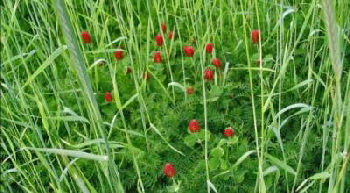Cover Crops for Small Gardens
You might wonder if you even need cover crops for your small backyard edible garden. But these green manures are easy and beneficial.
Most home gardeners never even consider cover crops, and those that have find all kinds of information for cover cropping acres of farmland so they assume cover crops are unnecessary for a small garden. Ok, so we know they help with erosion, but most of us have small flat gardens or boxed in raised beds that are not affected by water and wind erosion. But there are so many more benefits from cover crops.
The Benefits of Cover Crops for Small Backyard Gardens
Cover crops are well known as “green manure”
Reduce weeds
Prevent erosion
Break up heavy or compacted soil
Add organic material to improve soil structure
Improve soil fertility
Reduce the need to add compost, manure, and other organic amendments
Legume cover crops can fix (add) nitrogen to the soil
Your garden will look fresh and pretty even in the off season
Many cover crops produce
very deep roots, much deeper than you have ever pushed your shovel. Those deep, deep roots also encourage microbial activity far down in the soil so your soil is improved substantially deeper than an ordinary gardener’s routine improvements. Those same strong, deep roots also break up compacted soil beyond your reach, allowing your edibles to spread their roots as far as they care to. And the organic matter added to your soil by digging in your cover crop in spring will not only improve soil structure, but also improve moisture retention, drainage and aeration. You will be rewarded with stronger, healthier plants to produce a bountiful harvest.
Cover cropping is amazingly simple to do. Just rough up the soil surface with a gentle raking and sprinkle the seed. Cover lightly with a gentle raking to protect seeds from birds. You can plant your cover crop right after harvest or interplant a few weeks ahead of harvest so your cover crop has begun to establish by the time you complete harvest. In any case you will want to plant the seed about a month before expected frost, up two months if your crop is tender. You want to make sure it is well established before a killing frost.
In spring you can allow the crop to grow only until flowering begins, then (or sooner) mow them down and till them into the soil three weeks before planting your edibles. Or you can cut down the crop and use it as mulch, or just add it to your compost. If you pull the cover crop you can plant edibles right away, then use the pulled plants in your compost or for mulch. Most cover crops dug into the soil emit a substance that can hinder seed germination and growth for the first two or three weeks..
Best Cover Crops for Small Gardens
Annual cover crops are best for ease and low maintenance for the home gardener. Find out which covers are best for your region and soil. A mix of grasses and legumes is ideal to maximize the benefits of a cover crop. The legumes add nitrogen to the soil.
Annual Rye grass is so easy and readily available. It germinates quickly to reduce weeds and you can seed it before you even finish harvesting if you like. It is hardy to -10 degrees. Dig it into the soil in spring to add nutrients to the soil, but the cover grasses do not fix nitrogen to the soil.
Red Clover is a legume, so it does add nitrogen to your soil, and it is very pretty. Seed it early in spring to smother weeds if you like and dig it into the soil in spring. Red Clover produces edible flowers, but make sure they don’t go to seed as it can be invaseive. Red Clover grows about 18” high.
Buckwheat is a broadleaf, not a grass that resembles wheat. It is easy to grow, germinates in about a week, and matures in six weeks, very effectively controlling weeds all season if you like. Like many othercover crops, buckwheat increases soil health, provides organic matter, and often attracts beneficial insects. It can be tilled into the soil about 40 days after planting or in spring, or pull it right out easily. Don’t let the flowers go to seed!!, it will self seed readily and come up next spring all over your garden.
Winter Rye, appropriately named, will overwinter in most regions. It is hardy to -30 degrees. Plant in late summer or early fall after harvest. It will grow very rapidly and revive in spring. Till it into the soil a few weeks before planting your garden.
Hairy Vetch is popular with home vegetable gardeners because it is nitrogen fixing and performs well in a wide range of climates, soil conditions, pH and drought. The hardiest of the nitrogen fixing legumes, Hairy Vetch is winter hardy to zone 4. Plant Hairy Vetch just before or after harvest, till it into the soil in spring, or just mow it down leaving the top growth for mulch.
Barley is a quick growing nitrogen fixer. Barley is tolerant of most soil conditions with the exception of acidic soil. In the cold regions it won’t survive winter, but that is certainly not a problem. Left to overwinter the dead plan will protect your soil and be ready to use as mulch in spring.
Try it this year, it really is easy and does wonders for your soil.




